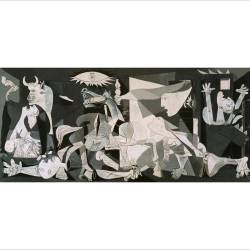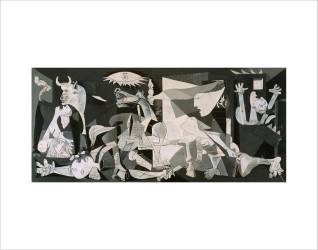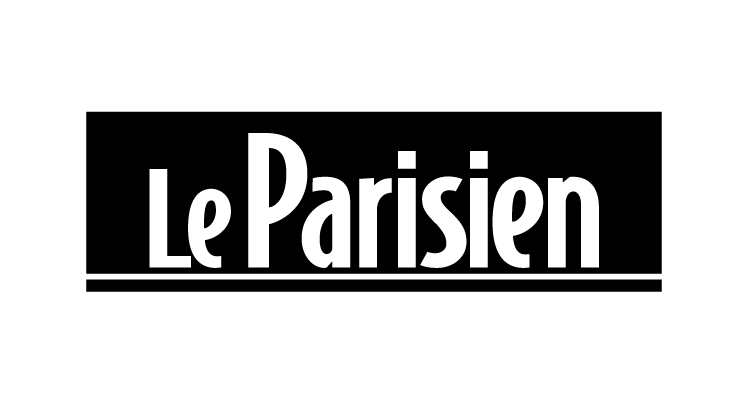Artwork of Pablo Picasso artprints & posters
Pablo Ruiz Picasso, one of the most famous artists of the 20th century, remains to this day a key figure in the history of art. Born in Spain, Picasso made an immeasurable contribution to various artistic movements. Best known as one of the pioneers of Cubism, his prodigious talent was not limited to painting. He also excelled in other forms of artistic expression, leaving behind him numerous paintings, drawings, sculptures and ceramics, among other techniques, forming a diverse and impressive cultural legacy.
Discover the works of Pablo Picasso, with ‘Guernica’, a true denunciation of the violence of the Spanish Civil War, ‘Les demoiselles d'Avignon’, the painting that initiated Cubism, and ‘Paul en Arlequin’, one of his portraits from his Rose Period.
Treat yourself to a reproduction of one of Pablo Picasso's paintings available in the catalogue, and discover the biography of this multi-talented painter, who permanently changed the vision of art in the last century.
Biography of Pablo Picasso
The beginnings of Pablo Picasso
Born in 1881, Pablo Ruiz Picasso was born into a family with a strong artistic background. His father, José Ruiz y Blasco, was a painter and art teacher in Malaga, and quickly introduced his son to art from an early age. And so it was that at the age of 8, the young Pablo Ruiz Picasso produced his first drawings and paintings, the most famous of which from this period remains ‘The Little Yellow Picador’, depicting a bullfighting scene, a theme that would be dear to the artist throughout his career. Following his father, who had lost his job at the provincial museum of Malaga, Picasso moved to La Coruña, before settling more permanently in Barcelona in 1895. This change of setting truly launched the beginning of Pablo Picasso's career. Entering the Llotja School (the Barcelona School of Fine Arts), Picasso set up his studio at the same time as his friend Manuel Pallarès, south of El Raval, a working-class neighbourhood in which the young painter produced numerous erotic drawings, a style of painting that would resurface later in the works of the Spanish painter.
After a brief stay in Madrid in 1897, then a short period in the village of Horta de Sant Joan, he returned to Barcelona and frequented the city's cultural venues, where he befriended many poets, artists and painters, such as Miquel Utrillo, Carles Casagemas, Jaume Sabartés, Julio González and Pablo Gargallo.
Pablo Picasso between Spain and Paris: The Blue Period and the Rose Period
Pablo Picasso represented Spain at the 1900 World's Fair in Paris with his painting ‘The Last Moments’. He travelled to the French capital and met the art dealers Pedro Mañach and Berthe Weill, who bought several of his paintings. After a brief return to Spain, to Malaga, Madrid, then Barcelona, the painter returned to France following the suicide of his friend Carles Casagemas, who would inspire him to paint ‘The Death of Casagemas’, the work that initiated his blue period. Inspired by the themes of melancholy and death, these works portraying human misery found few buyers, and Pablo Picasso lived in poverty during this period, despite the help of his father and despite an exhibition at the home of the famous art dealer Ambroise Vollard in 1901, and another at Berthe Weill's in 1902.
However, after setting up his studio at the Bateau-Lavoir and meeting Fernande Olivier, who became the Spanish painter's partner, he rediscovered his joie de vivre and began to change the tone of his painting. The blue period then gave way to the rose period and his warm-coloured canvases depicting harlequins and other acrobats. At the Bateau-Lavoir, he met the entire Parisian artistic sphere, such as Apollinaire and Modigliani, and in 1905 he became acquainted with the Stein couple, who bought many of his paintings, lifting the painter out of poverty. It was Gertrude Stein, whom Pablo Picasso would go on to paint in 1906, who introduced the Spanish artist to the French painter Henri Matisse, with whom he would form a true friendship.
Cubism: A turning point in the career of Pablo Picasso
In 1907, inspired by Cézanne, Pablo Picasso painted his famous work ‘Les Demoiselles d'Avignon’. This work would quickly be seen as a seminal painting of cubism, with its drawings intended to be in total opposition to the order established by artists such as Ingres or Matisse, and presenting women with forms reminiscent of African art or the deformation due to bone syphilis which Picasso suffered from. Initially surprised, Georges Braque followed suit and became a true companion of Picasso at the beginning of Cubism. A precursor of the various abstract movements, Cubism became an essential stage in the development of conceptual artists. With the help of Braque, Picasso deconstructed the object and multiplied the points of view on it, giving rise to Pre-Cubism with works such as Les Demoiselles d'Avignon, then Analytical Cubism, which went further in the deconstruction, with paintings such as Girl with a Mandolin or the ‘Portrait of Ambroise Vollard’, and finally synthetic cubism with paintings such as ‘Glass, Bottle of Wine, Packet of Tobacco, Newspaper’, which multiplies the media and integrates collage into the work.
In 1914, the First World War broke out. Unconcerned because of his nationality, Picasso left Paris for Italy with Jean Cocteau, and met the Russian artistic community, with Diaghilev, Stravinsky, or the dancer Olga Khokhlova, who would become his wife in 1918, and with whom he would have a son, Paulo, in 1921. Back in Paris, after a stay on the Côte d'Azur, Picasso broke away from Cubism, as evidenced by his works ‘Three Women at the Fountain’ and ‘Panpipes’, and painted his wife on numerous occasions, as well as his son, as in the painting ‘Harlequin with a Halo’.
Pablo Picasso and surrealism
From 1925, Pablo Picasso was influenced by surrealist art, which was in vogue in the French capital. The Spanish artist then fitted perfectly into the junction between the surrealist movement and cubism, allowing emotions and thought to shine through, while leaving little room for dreams and concentrating on the object itself. He would thus deconstruct his subjects in order to allow their inner thoughts to shine through. Presenting several of his works to the public, such as at the first surrealist exhibition at the Galerie Pierre, it was also during this period that Picasso began to produce sculptures, trained by his friend Julio González, with whom he collaborated on numerous projects. During the 10 years he spent with the Surrealists, the artist received numerous commissions and produced a large number of works, such as ‘Baigneuse assise’ (Seated Bather), ‘La Femme au jardin’ (Woman in the Garden), ‘Crucifixion’, ‘Deux figures au bord de la mer’ (Two Figures by the Sea) and paintings on the theme of the Minotaur, which he took a liking to after fulfilling a commission from Albert Skira's surrealist magazine ‘Minotaure’. On a personal level, from 1926, the Catalan painter began a relationship with Marie-Thérèse Walter, the model for his painting ‘Bust of a Young Girl’. She became his new muse, and he alternated between her and his wife Olga, before leaving her in 1935, on the arrival of Maya, the daughter he had with Marie-Thérèse. But after 10 years of playing both sides of the fence, Picasso met Dora Maar, a photographer who was a regular at the Parisian Surrealist circle, while continuing his relationship with Marie-Thérèse Walter.
War as seen by Pablo Picasso
A profound pacifist, Pablo Picasso depicted the horror of war in a large-scale canvas: ‘Guernica’. Painted during the Spanish Civil War, this painting depicts the drama of the bombing of Guernica, carried out by Nazi planes and orchestrated by General Franco. This monumental cubist and surrealist painting, presented at the International Exhibition in Paris in 1937, aims to represent the suffering and cruelty caused by war through art, using strong symbols that reveal the painter's emotions.
Although he was not much of a threat during the Second World War, Picasso was still listed as an anarchist by the Nazis. In particular, he joined the French Communist Party in 1944, influenced by the French communist resistance against the occupation, but although close to the party's ideas, the Spanish painter would publicly stand up against it on numerous occasions using his art, in particular to denounce the Korean War or to speak out against the intervention of the Red Army in Budapest.
Pablo Picasso moves to the south of France
In 1945, Pablo Picasso left for Antibes in the south of France, then travelled to Golfe Juan to join his new love, whom he had met in 1944: Françoise Gilot. After visiting Henri Matisse in 1946, he discovered the town of Vallauris, with which he fell in love and where he settled in 1948, a year after the birth of his son Claude, born a year earlier from his relationship with Françoise. In 1949, Claude's sister Paloma was born, before Françoise Gilot left him in 1953 and he joined Jacqueline Roque in Cannes in 1955. During this period in Vallauris, Pablo Picasso produced numerous works such as ‘La Cuisine’, ‘La Guerre et La Paix’ (visible in the old chapel of Vallauris, now the Picasso Museum), and ‘Massacre en Corée’. But it was mainly during his stay that he tried his hand at other arts such as linocut and especially ceramics, producing more than 4,500 pieces, after Suzanne and Georges Ramié had introduced him to it.
At the Villa Californie in Nice, he continued to paint and discovered the technique of gemmail, using it to produce several works such as ‘Woman in a Wicker Armchair’, ‘Self-Portrait “Yo”’, and ‘Portrait of Marie-Thérèse Walter’.
In 1959, Pablo Picasso moved to Vauvenargues, and made his first drawings with the theme ‘Le Déjeuner sur l'herbe d'après Manet’. In 1961, Jacqueline Roque became his wife, and he returned to the Cannes area to settle at the mas Notre-Dame-de-Vie in Mougins, where he would spend his last years.
A chaotic end to his life and legacy
During the last years of his life, Pablo Picasso continued to produce drawings and engravings which he exhibited regularly, particularly at the Louise Leiris gallery in Paris. Picasso's work consists of an immense collection of paintings, and retrospectives were organised during his lifetime, at the Grand Palais and the Petit Palais in Paris in 1966, in 1970 in Avignon at the Palais des Papes, and also in Barcelona at the Picasso Museum, a venue entirely dedicated to the painter's work, and open since 1963.
Pablo Picasso, who enjoyed great success for most of his career, died in 1973 at the age of 91. With a plethora of paintings, sculptures, drawings and all other forms of art, in addition to his numerous properties, Picasso never having made a will, the succession proved to be stormy. It took more than four years of inventory to determine the amount of the estate, and the distribution among the various children, some of whom were born out of wedlock (such as his daughter Maya, his son Claude and his second daughter Paloma), was the result of a real legal battle. Marie-Thérèse Walter, Maya, Claude and Paloma were also prohibited from attending the painter's funeral, which suggests that the distribution of his estate among the various women and children Picasso had during his lifetime would be complicated.
More recently, in 1995, the company Picasso Administration was created to prevent the artist's work from being disseminated, to ensure that rights are respected and that the works are authenticated.
Pablo Picasso: A work that has become unmissable
Having become an unmissable artist during his lifetime, Picasso was able to create a whole collection of works that had an impact both artistically and personally. Having repeatedly depicted the different women in his life, including Olga Khokhlova, Marie-Thérèse Walter, Dora Maar, Françoise Gilot and Jacqueline Roque, to name the most important, he also took a stand against war and violence by painting major works such as ‘Guernica’ and ‘The Dove of Peace’.
An innovative artist, Picasso was not content to copy a style, but carried out a great deal of research that naturally led him to the creation and development of cubism, with his painting ‘Les Demoiselles d'Avignon’, a style he developed with Georges Braque, and of which he was the main representative with an impressive gallery of works. The Spanish artist also tried his hand at other art forms throughout his career, creating sculptures and experimenting with the techniques of gemmail, linocut and ceramics.
The result is an enormous collection of paintings, sculptures and other works produced using a wide variety of techniques, which today can be found in the world's greatest museums, from the Picasso Museum in Barcelona to those in Paris and Vallauris, as well as the Museum of Modern Art in New York, the Berggruen Museum in Berlin and the Philadelphia Museum of Art. A large private collection with works such as ‘Boy with a Pipe’ (1905, private collection), ‘Two Standing Nude Women’ (1908, private collection), ‘Dora Maar with Cat’ (1941, private collection), ‘Le Rêve’ (1932, private collection) and ‘Nu aux bras levés de profil’ (1908, private collection), among hundreds of others, also exist, making Picasso's work one of the most important and valuable for such a renowned artist.





























